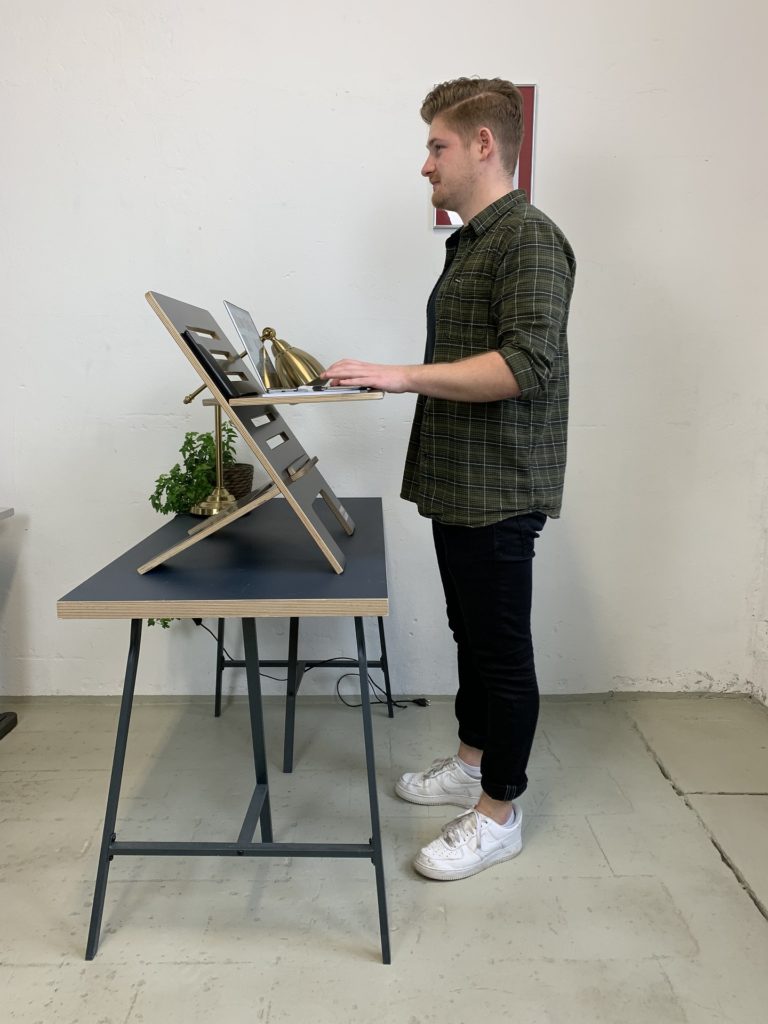All over the United States, students of all ages spend large amounts of time sitting while they focus on their studies. We can spend long periods of time hunching over a textbook or a computer screen. These activities, however, can have their consequences.
Mike Breneman, a Dayton area physical therapist, has found that sitting for short periods has not caused issues, but rather extended periods of sitting, such as 10 to 30 minutes, that can lead to different problems.
“I think to a degree, a lot of chronic problems in life can be traced back to sitting postures and how we are moving throughout the day,” said Breneman. “Postures that are bad, for example, can eventually lead to strain or malalignment in the spine. You are getting pressure… [in an area] that’s not meant to take pressure for that period of time.”
Breneman has seen a lot of long-lasting chronic pain that has developed from bad sitting and posture habits. Problems such as this can lead to doctor visits and pain medication.

“I find that…40 or 50 percent of what I see are probably tied back to sitting activities,” said Breneman. He explained that these issues can consist of back and neck pain.
Along with back pain, a range of other problems can also result from extended sitting and poor posture, including headaches and muscle strains or weakness. Sometimes these issues can be long-term. Problems could also be seen in the shoulders:
“If you’re sitting rounded all day long and your arms are out in front of you, the front part is probably going to be over-used and tight and the back is going to be overstretched and weak,” said Breneman. “I’ll find shoulder problems … in adults when they go to lift and do things that become harder or painful because of posture and positions that…[occur] over months and years.”
These bad activities can lead to irritation and inflammation in the shoulder, sometimes long-term, that can be felt during normal everyday activities such as reaching the arm up.
“From that aspect, it can be affecting the quality of life,” said Breneman.
As college-level work can often result in more time dedicated to studies, and therefore more sitting, this can cause changes in the way students feel.

“Some people’s extra-curricular lifestyles change, so they don’t do the same type of activities that they necessarily did in high school,” said Breneman. “There’s a shift, I think, in how much sitting we’re doing versus what we weren’t doing before.”
Breneman gave advice on how we should position ourselves when we do sit so that we can reduce stress or strain on our bodies:
“The first thing to do is to make sure that if you’re sitting for a while, your feet should be in contact with the floor,” he said. “Try to make sure your knees and hips are at 90-degree angles. [Avoid] relaxing too far back in the chair… [and] get into an upright posture or position. If you’re sitting, you want to make sure that your arms and hands aren’t far out in front of the body. The closer that you keep your arms to your body while you’re doing schoolwork [or] typing…the less your body has to work.”
Breneman also recommended that students attempt to get up every half hour to move the body through stretching or walking and to change to a different position.
Students that often lean to one side or lay on their chair or desk while working should make an attempt to sit straight for at least a portion of the time to avoid these stressful body positions for long periods.
“Trying to stay upright and tall for a long period of time will make you sore for most people because you’re not used to using those muscles in that position,” said Breneman. “[You can] lean on one hip for a little bit, [called] dynamic sitting, so that you’re shifting weight [and] taking pressure off areas.”
If it is challenging to sit straight for longer periods, people can try to sit in that position for at least five to ten minutes so that they can avoid a slouching position for a portion of the time.
People can also work on stress management. This can include simply walking around, drinking water, or stretching.
“If you think about it this way, our bodies are basically machines,” said Breneman. “We’re meant to move versus not move. If you’re sitting [and] not doing anything, you’re not burning [many] calories, your energy expenditure is pretty low and you’re potentially in postures that may not be ideal for those muscles of the back over time.”
He explained that sitting for long periods can have the same effect as lifting incorrectly.
Sometimes it is hard to realize you are sitting in a bad position until pain kicks in later. Breneman recommended that people set a reminder, such as on their phones, for every 45 minutes to an hour so that they can get up and move as well as readjust their posture or the position they are sitting in.
“Your body is a complete unit,” said Breneman. “In other words, get a look at how you’re moving or how you’re not moving. I would recommend three to five days a week of…moderate intensity strengthening and up to four to five days of some form of walking, light aerobic or endurance activities.”
Breneman explained how sometimes people are in situations where they are required to sit for long periods, such as at their jobs. He suggested that people look to see if their activity level is enough to create a balance with the time they spend sitting.
“It [sitting] might be unavoidable to some degree,” said Breneman. “If you’re sitting for eight to nine hours out of the day, try to get at least an hour or two of up moving around to offset that.”
Students might give their body a break by standing up and reading. Breneman suggested that books or computers be kept at eye level while sitting as looking down or to the side can cause strain. There are also actions that people can take at their jobs:
“I love the idea of… a standing desk, especially if they’re at work,” said Breneman. “If they get the work done, I would say get up and move around. Going for a walk… [helps to] reset the body and gets the blood flowing again.”

He also suggested that students who work have an accountability partner. They can ask a reliable co-worker to make them aware of any slouching that they may be doing as a reminder to sit up straight.
“If they see you taking an initiative to try to be conscious of your body’s mechanics, that might encourage them,” said Breneman. “I find people are more successful if they have accountability partners.”
There are other factors that can be considered when managing pain. This includes rest, hydration, and a healthy diet.
“Adequate rest may not seem like it’s tied into pain, but if you don’t rest well, then you can’t heal well,” said Breneman. “If you are struggling with pain issues or problems, you’ll find your perception of pain or your body’s response to pain is much more noticeable.”
Combining the different areas of posture, exercise, hydration and dieting can help people to receive some of the best results.
“You’ll probably find, if you address all the different [areas], your overall attack on pain goes down – hopefully significantly, but overtime a lot better,” said Breneman.
People can even help their posture while driving. They can do this by adjusting their seat so that it is set up similar to a chair at a desk.
“You may not get ninety at the knees, but certainly try to make sure your back…[and] head are upright [and] you’re not having to lean too far forward to the steering wheel,” said Breneman.

He also recommended that people adjust their rearview mirror so that it requires them to sit up taller. This is a small act that can make a difference in posture.
With today’s advancement in technology, many people spend large amounts of time in front of screens. This is even more common now as people are taking classes over a live feed with the pandemic. Breneman said that college students are not an exception to this.
“You might find a lot of times that people are looking down on their phones, which is equivalent of sitting in a bad posture with your head forward for hours,” said Breneman. “Sometimes the amount of time on screens or even reading [can cause issues] if your head is down a lot, so try to minimize that screen time.”
A step that people can take is checking if their phones have a feature that tells them the amount of screen time they have had. Being aware of this can help reduce screen time, and therefore, pain.
Rebekah Davidson
Intern


